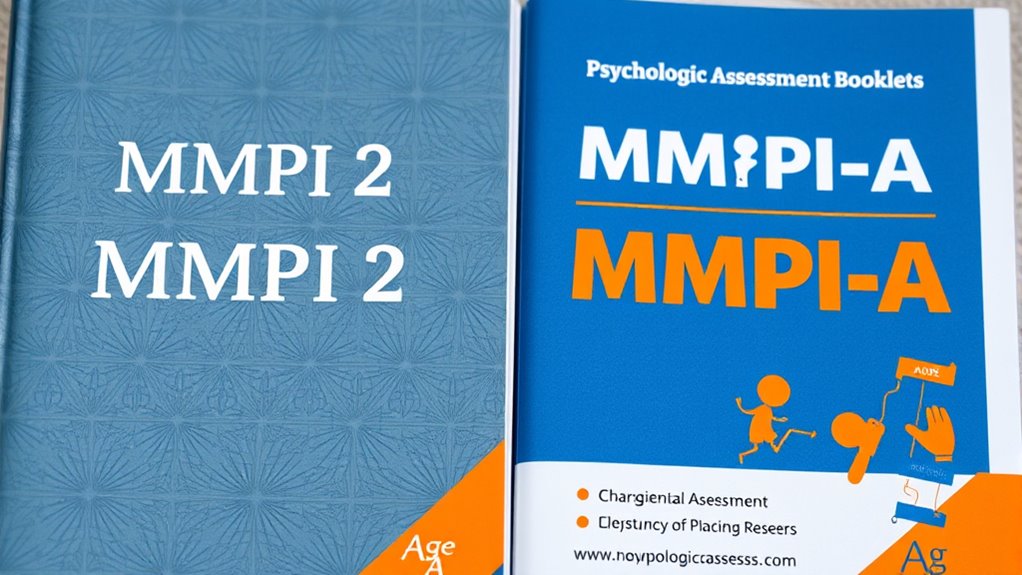The MMPI-2 and MMPI-A differ mainly in their focus on populations; the MMPI-2 is for adults, while the MMPI-A is designed specifically for adolescents aged 14–18. Their items are worded differently to suit developmental stages, and each uses norms relevant to their age groups, affecting score interpretation. The administration process also includes adjustments to help adolescents feel more comfortable. If you keep exploring, you’ll discover even more about these important assessment tools.
Key Takeaways
- MMPI-A is specifically designed for adolescents aged 14-18, while MMPI-2 targets adult populations.
- Items in MMPI-A are modified for age-appropriate language and developmental understanding.
- MMPI-A uses adolescent-specific normative data, unlike MMPI-2’s adult norms.
- Interpretation of MMPI-A scores considers adolescent developmental issues like identity and peer influence.
- Administration procedures for MMPI-A include additional support to ensure adolescents understand and feel comfortable.

The MMPI-2 and MMPI-A are both widely used psychological assessment tools, but they serve different populations and purposes. As you navigate these tests, understanding their differences in score interpretation and administration procedures becomes essential. The MMPI-2 is designed for adults, while the MMPI-A targets adolescents aged 14 to 18. This distinction influences how the tests are administered and how their results are interpreted. When you administer the MMPI-A, you need to be mindful of the developmental level of teenagers, which affects how questions are understood and answered. The wording of items is often adjusted to be age-appropriate, providing clearer insight into an adolescent’s mental health status. Additionally, modifications in question phrasing help accommodate adolescents’ cognitive and emotional development, making the assessment more accurate. Score interpretation also differs between the two. For the MMPI-2, clinicians analyze scores based on adult norms, considering the personality structure and psychopathology typical in adult populations. In contrast, the MMPI-A uses normative data specific to adolescents, which accounts for developmental stages, social influences, and emotional challenges unique to teenagers. When you interpret scores from the MMPI-A, you look for patterns that might reflect issues like identity development, peer pressure, or academic stress, which are less prominent in adult assessments. This tailored approach helps in accurately identifying concerns relevant to adolescents. The administration procedures for both tests involve a standardized process, but subtle differences exist. The MMPI-2 is usually administered in a quiet, controlled environment, with instructions that emphasize honesty and comfort. The MMPI-A follows similar procedures but often incorporates additional considerations for adolescents, such as ensuring they understand the purpose of the test and feel at ease. Sometimes, you might need to provide extra support or clarification to help teenagers feel comfortable responding truthfully. Proper test administration procedures and adolescent-specific norms are essential for reliable results. Timing is another factor. The MMPI-2 typically takes about an hour to complete, while the MMPI-A might be slightly shorter or longer depending on the individual. Both tests are administered in paper-and-pencil formats or digitally, but the key is to ensure standardized procedures are followed to maintain reliability. As you interpret the results, remember that the normative data for adolescents help you distinguish between typical developmental behaviors and significant psychopathological symptoms.
Frequently Asked Questions
How Are the Scoring Methods Different Between MMPI-2 and MMPI-A?
You’ll notice that the scoring algorithms for the MMPI-2 and MMPI-A differ to accommodate age-specific norms. These differences influence how you interpret results, as the MMPI-A uses interpretation standards tailored for adolescents, while the MMPI-2 applies adult norms. This guarantees accurate assessment by considering developmental factors, so you can confidently analyze each test’s outcomes based on the appropriate scoring methods and interpretation standards for the age group.
What Age-Specific Norms Are Used for MMPI-A?
You might think adolescent development is a tiny detail, but it’s actually the foundation of MMPI-A’s accuracy. The test uses age-specific norms based on a large, diverse sample of adolescents, ensuring your responses are compared to same-age peers. This way, the normative comparisons accurately reflect typical behaviors for each developmental stage, making the results truly meaningful and tailored to the unique emotional and psychological landscape of adolescence.
How Do the Validity Scales Differ Between the Two Tests?
You’ll notice that validity scale variations between the MMPI-2 and MMPI-A can lead to interpretation challenges because the scales are tailored to different age groups. The MMPI-A includes additional or modified scales to account for adolescent behaviors, which can complicate direct comparisons. These differences mean you need to carefully consider each test’s validity scales to accurately interpret results, especially since adolescents might respond differently than adults on certain validity measures.
Can the Tests Be Administered in the Same Settings?
You can administer both tests in similar settings, such as clinics or schools, but you need to take into account the testing environment’s appropriateness for adolescents. Make sure the environment is quiet and private to reduce distractions. Additionally, the administrator must be trained to work with the specific age group, understanding developmental differences. Proper training helps in managing the session effectively and interpreting results accurately, making the testing process smoother for both tests.
Are There Specific Mental Health Conditions Better Identified by One Test?
You’ll find that the MMPI-2 excels at identifying adult-related issues, while the MMPI-A is tailored for age-related assessments in adolescents. Each test is better suited for detecting specific conditions, such as mood disorders and personality issues in adults, or behavioral and developmental concerns in teens. By matching the test to the age group, you enhance condition detection and guarantee more accurate, relevant results for each individual’s mental health needs.
Conclusion
As you explore the worlds of MMPI-2 and MMPI-A, imagine stepping into two different landscapes—one for adults, with its complex terrains, and one for teens, lively and evolving. The MMPI-A guides adolescents through a colorful maze of emotions, while the MMPI-2 offers a more structured pathway for adults. Both tests help you navigate your inner landscape, revealing hidden treasures and shadows alike. Embrace these tools as your map to understanding yourself better.









